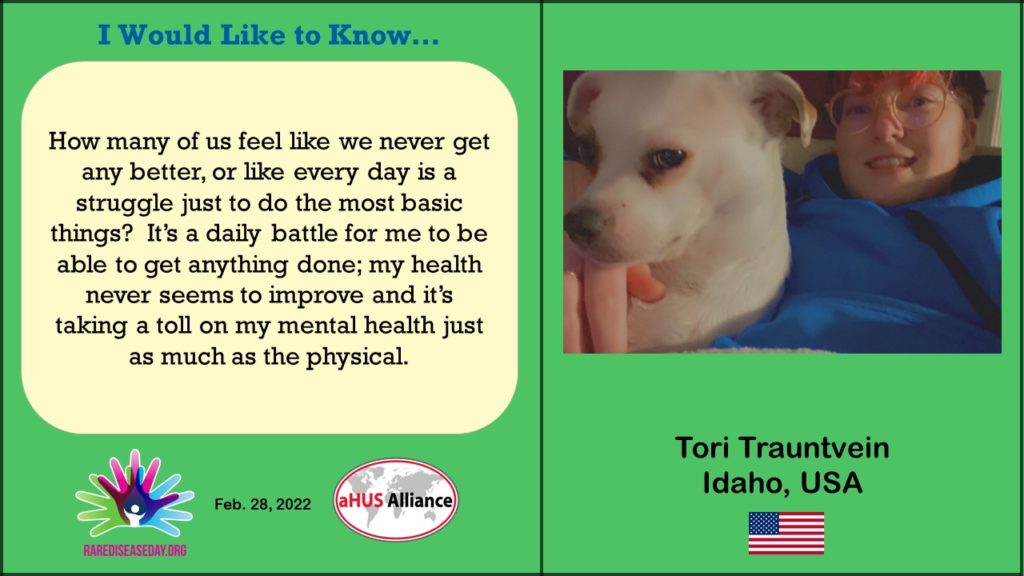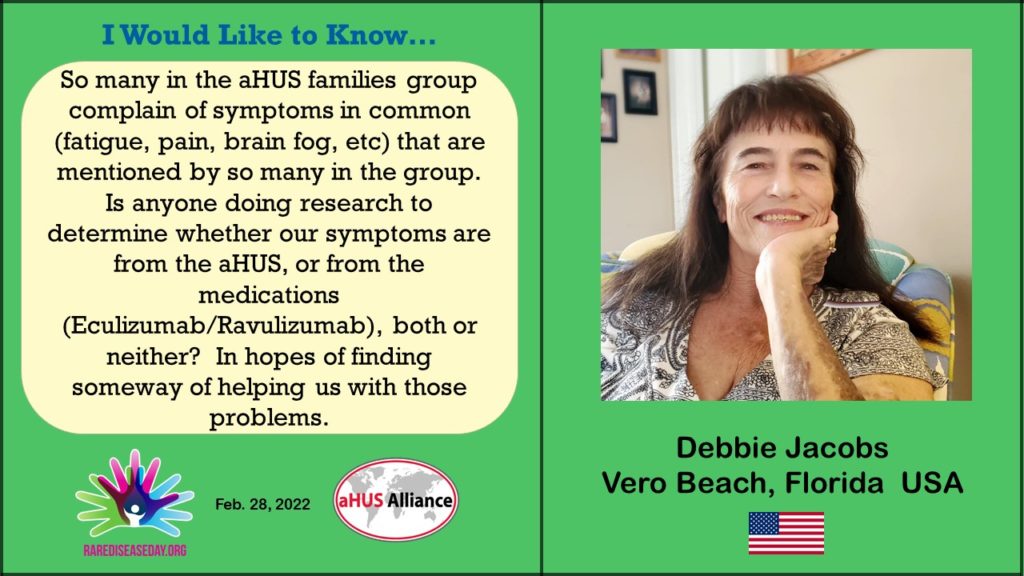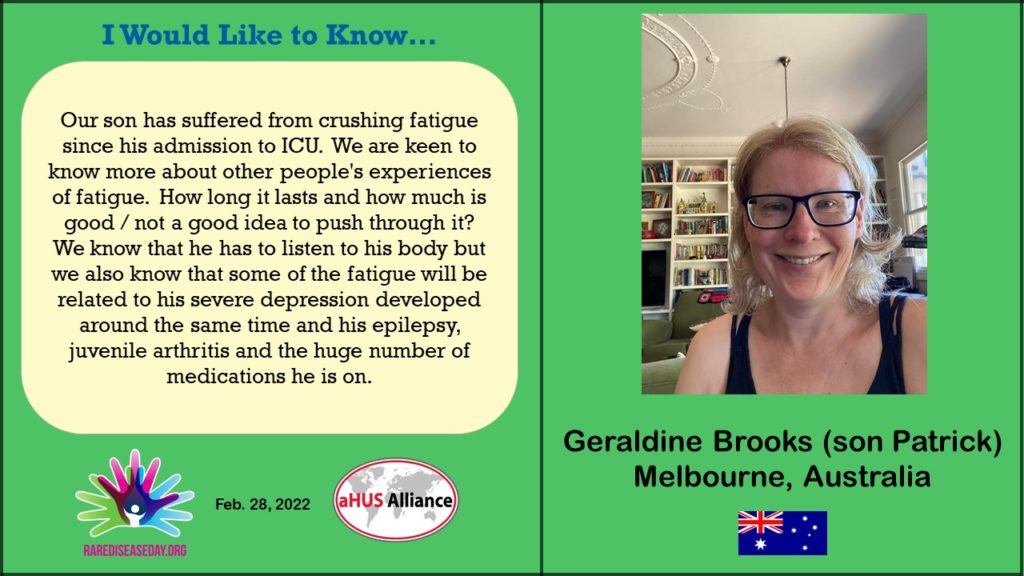Long term aHUS disease, diagnosis and treatment legacies on both physical and mental health have featured in two aHUS Patient Research Agenda topics.
The damage to the body during an aHUS episode may take time to recover and psychological impact of being in a critical life threatening state, often with clinical uncertainty about both what is causing it and what can be done to stop it takes its toll. Coming to terms with it all needs time

Energy and fitness are casualties of the serious illness aHUS, Tori.
Loss of red blood cells and the part they play in getting oxygen from the lungs to all parts of the body is part of the aHUS disease process. The damage to the kidneys also limits their ability to produce a hormone to stimulate red blood cell production to replace those lost. A severe anaemic state for most patients.
Although the general population has some feeling of fatigue, life is like that, aHUS patients report very high levels of fatigue. aHUS patients on dialysis report significantly more fatigue than those rapidly diagnosed and treated.
Recovering from aHUS for many depends on how much lost kidney function returns after the acute kidney injury and how soon red blood cells are fully replaced. Fitness recovery depends on rebuilding muscle power lost when inactive and that depends on the lung function getting back to normal to get oxygen into the blood quicker for more activity. It is a natural process.
Just as all was lost in a downward spiral when patients became ill , fitness returns in an upward spiral.
It is much harder for those on dialysis to recover than those who experienced less or no kidney function loss. Erythropoietin ( EPO) can help. Injecting this hormone , usually produced by the kidneys, sends a message to the bone marrow to produce more red blood cells.
So basic clinical tests need to show blood results returning to normal ranges. If not, medical intervention is needed, for example iron or sometimes blood transfusions.
But what if all results are in the normal range and time is passing?
Fatigue is associated with impaired productivity, depression and decreased quality of life.

Fatigue, confusion etc are being investigated in a long term study of patient reported outcomes from those participating in a Global aHUS Registry, Debbie. The Registry is a long term observational study which began ten years ago.The aHUS patients in it may, or may not have been treated with eculizumab. One of the patient reported outcome tools is known as the FACIT – Fatigue questionnaire.
For adults it is made up of 13 statements to which respondents say how much each statement matches how they have felt in the past seven days.
Each is scored on the basis: Not at all=0, A little bit= 1, Somewhat= 2, Quite a bit= 3 , Very much = 4.
I feel fatigued …………………………………………………………..
I feel weak all over ……………………………………………………
I feel listless (“washed out”) ……………………………………….
I feel tired………………………………………………………………..
I have trouble starting things because I am tired……………..
I have trouble finishing things because I am tired …………..
I have energy* ……………………………………………………………
I am able to do my usual activities*……………………………….
I need to sleep during the day ……………………………………..
I am too tired to eat……………………………………………………
I need help doing my usual activities ……………………………
I am frustrated by being too tired to do the things I want to do ……………………………………………………………………….
I have to limit my social activity because I am tired…
To get to an overall score, each of the answers for all statements, apart from those marked * , are deducted from a value of 4. For the two marked * the answer given is added to 0. Then all the “reversed” scores are added up.
The maximum score is 52 for adults , 13 reversed scores of 4 , i.e.no fatigue at all. Any score below that reveals the relative level of fatigue felt by individuals. Collectively the scores of all patients provide averages , means and median, statistics for this sample of aHUS patients.
In the Registry results gathered from 551 aHUS patients investigators reported overall median scores of 41, 43, and 42 for patients on eculizumab (at 18 months follow up), on eculizumab (at 2 years) and never been on eculizumab (at 30 months) respectively, Geraldine and Patrick. For those patients with just two years of follow up, patients on dialysis scored 36, those with transplants 40 and those never on dialysis 44.5. The general population average fatigue score is 44. So ,at that time, most but not all , aHUS patients were feeling “above” what would be regarded as normal levels of fatigue.
A difference of 3 in FACIT Fatigue scores is significant. At time of illness overall patients reported a fatigue level of 32. Dialysis patients reported 26. Theses are median scores, so at least 50% of patients are higher and 50% lower. Some patients at the top and bottom scored themselves as 52 and others at 0 respectively so quite a spread. Overtime some improve , some stay the same, some even report getting worse.
Other patient symptoms compared in the study include anxiety, diarrhea, easy bruising/abdominal bleeding, irritability, nausea/vomiting, shortness of breath, swelling, weakness, abdominal or chest pain , jaundice and confusion. Feeling anxious is natural when someone is in the midst of a serious illness. Levels should fall with treatment and physical recovery. However , whatever their treatment mode, it does not seem go away for around a third of aHUS patients. The other mental health condition , confusion, is reported by 10 to 20% of patients. Falling but not disappearing in time.

So far investigators have published one article based on what patients have reported at time of entry into the Registry, and then followed up every six months up to July 2019. It will probably be another two year or so before another such report is published. It would be valuable to know what happened to the same patients after a further three years.
The Registry is not set up to record what medical interventions have been tried, nor can it seek medical interventions to see what happens. It can only observe. The comparative experiences of those who have not been treated with eculizumab and those who have can be observed.
Furthermore there is an adverse event reporting system for all patients on eculizumab whether in the Registry or not. Some of these adverse events are categorised as serious , or “SAEs” as they are called. Patients’ clinicians can report to Alexion anything which is considered linked to the drug and Alexion must record investigate and report it if serious enough. This would happen in drug trials too and safety reports are provided to licensing authorities like the FDA.
More research is needed outside of the aHUS Registry too on:
–fatigue and other symptoms recovery timeline,
-the different patient characteristics and experience between those in the bottom half of the fatigue spectrum and those above,
-knowing about any interventions tried and their effectiveness.
Also perhaps in time the wider impact on patients’ family too, as health policy decision makers also take into account impact on them when making decisions about new drugs. It needs someone to do the research, including aHUS patients playing their part.
In the mean time recognising that there are to a greater, or lesser, degree some long term effects from an aHUS encounter is a start.
Also as is the fashion, since the COVID pandemic, giving it a name of “LONG aHUS” may help give it a focus.
Article No. 491
Previous article :
LONG aHUS
aHUS alliance Global Action has previously brought up the concept of “Long aHUS ” in its articles during the COVID pandemic. An enormous amount of publicity has been given to…CONTINUE READING

